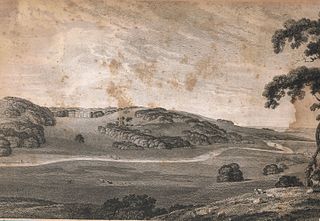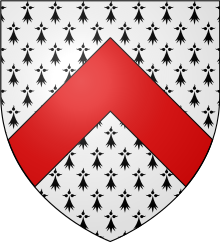
Earl of Castlehaven was a title in the Peerage of Ireland, created on 6 September 1616. It was held in conjunction with the Barony of Audley, the Barony of Audley of Orier, and the Barony of Audley of Hely.

George Tuchet, 1st Earl of Castlehaven, was the son of Henry Tuchet, 10th Baron Audley and his wife, née Elizabeth Sneyd.

Mervyn Tuchet, 4th Earl of Castlehaven was the third son of Mervyn Tuchet, 2nd Earl of Castlehaven, and his first wife, Elizabeth Barnham. He succeeded his brother James Tuchet as Earl of Castlehaven on 11 October 1684. He also held the subsidiary titles 14th Baron Audley and 2nd Baron Audley of Hely.

Baron Audley is a title in the Peerage of England first created in 1313, by writ to the Parliament of England, for Sir Nicholas Audley of Heighley Castle, a member of the Anglo-Norman Audley family of Staffordshire.

James Tuchet, 5th Baron Audley, 2nd Baron Tuchet of Heleigh Castle was an English peer.
The Lords of Cemais were the ruling families, from the early 12th century of the Marcher Lordship of Kemes, and in later centuries of the barony of Cemais (Dyfed).
Elizabeth Stafford, Countess of Sussex was an English noblewoman.

John Bourchier, 2nd Earl of Bath was an Earl in the peerage of England. He also succeeded to the titles of 12th Baron FitzWarin, Baron Daubeney and 4th Count of Eu.

James Tuchet, 7th Baron Audley was a British nobleman and the only lord to fully join the Cornish rebellion of 1497 opposing the rule of Henry VII of England. He was a leader in the rebel army's march to the edge of London, and in its defeat at the Battle of Deptford Bridge. Captured on the battlefield, he was sentenced for treason and beheaded. His peerage was forfeited, but restored to his son in 1512.
Tuchet is a surname, and may refer to:

James Audley, 2nd Baron Audley of Heighley Castle, Staffordshire, was an English peer. He was the son and heir of Nicholas Audley, 1st Baron Audley (1289–1316) by his wife Joan Martin, who was the daughter of William Martin, feudal baron of Barnstaple, and Marcher Lord of Kemes. She was posthumously the eventual sole heiress of her brother William FitzMartin to Barnstaple and Kemes.

John Tuchet, 8th Baron Audley, 5th Baron Tuchet was an English peer.

John Tuchet, 6th Baron Audley, 3rd Baron Tuchet was an English politician.
Richard Grey, 3rd Earl of Tankerville, 8th Lord of Powys fought on the side of the House of York in the War of the Roses.
Sir Arthur Pole of Broadhurst, near Horsted Keynes in Sussex was an English knight.

From AD 1066, the feudal barony of Barnstaple was a large feudal barony with its caput at the town of Barnstaple in north Devon, England. It was one of eight feudal baronies in Devonshire which existed in the Middle Ages. In 1236 it comprised 56 knight's fees or individual member manors. The feudal service owed for half the barony in 1274 was the provision to the royal army of two knights or four sergeants for forty days per annum, later commuted to scutage.

The historic manor of Tawstock was situated in North Devon, in the hundred of Fremington, 2 miles south of Barnstaple, England. According to Pole the feudal baron of Barnstaple Henry de Tracy made Tawstock his seat, apparently having abandoned Barnstaple Castle as the chief residence of the barony. Many of the historic lords of the manor are commemorated by monuments in St Peter's Church, the parish church of Tawstock which in the opinion of Pevsner contains "the best collection in the county apart from those in the cathedral", and in the opinion of Hoskins "contains the finest collection of monuments in Devon and one of the most notable in England".

Margaret II Audley was a co-heiress to the feudal barony of Barnstaple in Devon, England.

Thomas Luttrell, of Dunster Castle in Somerset, feudal baron of Dunster, was a Member of Parliament for his family's newly enfranchised pocket borough of Minehead, from 1563 to 1567. He was Sheriff of Somerset in 1570–1.

The title Baron Cobham has been created numerous times in the Peerage of England; often multiple creations have been extant simultaneously, especially in the fourteenth century.










